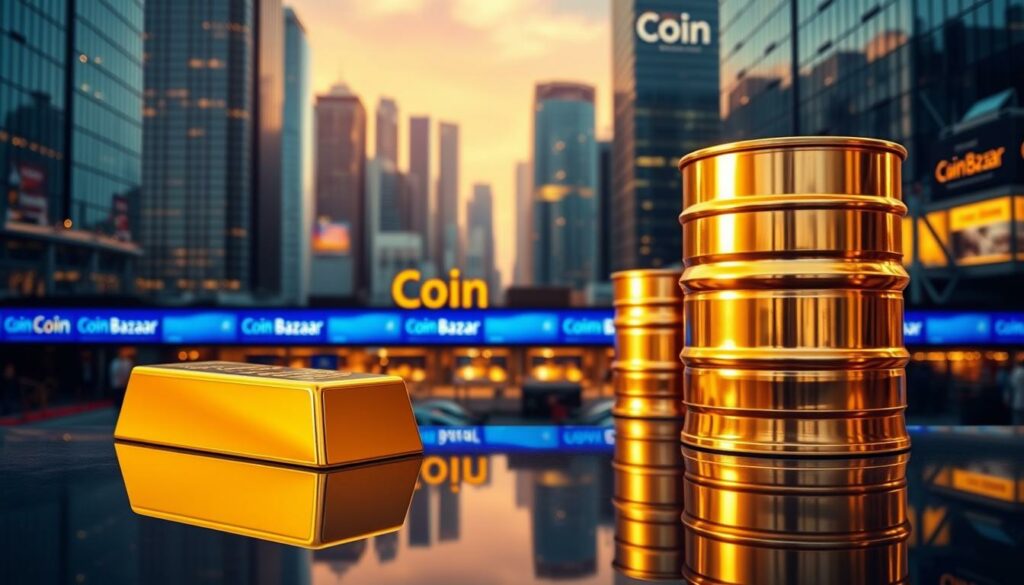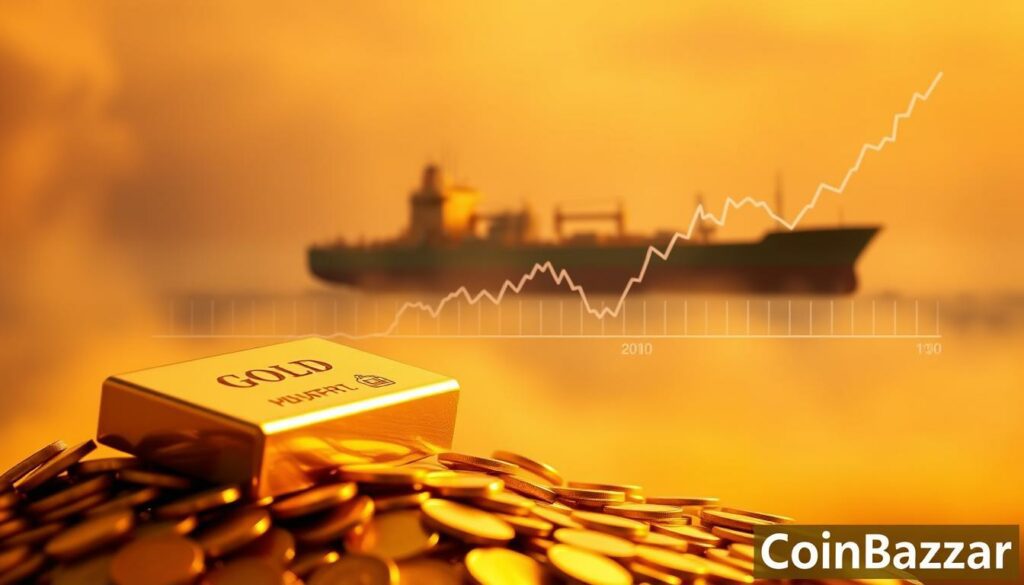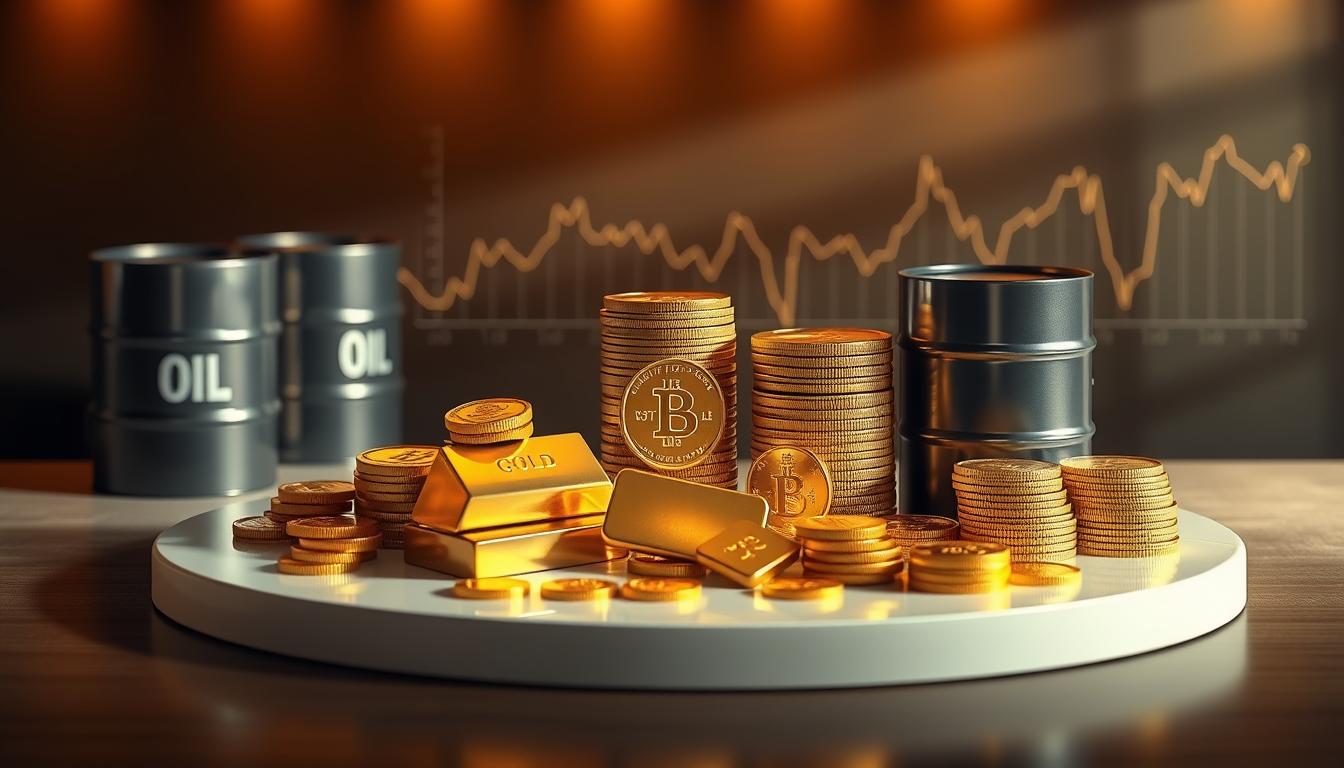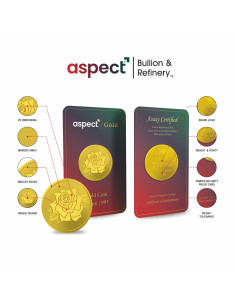Exclusive Deals & Trending Items


Muthoot Pappachan Swarnavarsham BIS Hallmarked Gold Heart Bracelet of 8 gms in 22 KT 916 Purity Fineness
Shop NowGeopolitical tensions can really change commodity prices. The US and Iran’s recent issues have pushed oil prices up. This makes investors think about how it might affect gold bullion and coin investments.
Jason Ma’s article notes that wars don’t usually keep gold prices high for long. But, the U.S. budget deficit could change that.
The link between gold and oil prices is tricky. Knowing this is key for smart investment choices. When oil prices go up and tensions rise, it’s important to see how it might change gold’s value.
Key Takeaways
- The US-Iran strain has caused a surge in oil prices.
- Geopolitical conflicts aren’t typically long-term drivers for gold prices.
- The U.S. budget deficit is likely to impact the outlook for gold.
- Understanding the relationship between gold and oil prices is crucial for investment decisions.
- Rising oil prices and geopolitical tensions can influence the value of gold.
The Historical Relationship Between Gold and Oil
For decades, gold and oil prices have been linked. They are influenced by economic indicators and market trends. Knowing this relationship helps you make smart investment choices in the commodity market.
The connection between gold and oil prices is not random. Both are often used as hedges against inflation and market ups and downs. When oil prices go up, it can cause production costs to rise. This can lead to inflation, making gold a good choice for investors looking for safe assets.
Price Correlation Patterns Over Decades
Gold and oil prices have sometimes moved together, sometimes apart. For example, in the 1970s oil embargo, both prices soared. This was due to geopolitical tensions and worries about inflation.


Key Historical Events That Shaped the Gold-Oil Dynamic
Several events have shaped the gold-oil relationship. The table below shows some of these important moments:
| Year | Event | Impact on Gold and Oil |
|---|---|---|
| 1973 | Oil Embargo | Prices of both gold and oil rose sharply. |
| 2008 | Global Financial Crisis | Gold prices surged as investors sought safe havens, while oil prices initially dropped before recovering. |
By looking at these historical patterns and events, you can better understand how gold and oil prices might interact in the future. This is especially true during times of geopolitical tension, like the current US-Iran conflict.
Gold vs Oil: Understanding the Fundamental Price Ratio
The relationship between gold and oil prices is key for investors looking to diversify. The gold-oil ratio shows how these prices compare. It helps spot economic trends and investment chances.


How to Calculate and Interpret the Ratio
To find the gold-oil ratio, divide gold’s price by oil’s price. For example, if gold is $1,800 per ounce and oil is $60 per barrel, the ratio is 30. This means 30 barrels of oil equal one ounce of gold.
Understanding this ratio helps grasp market mood and economic health. A high ratio might mean gold is too expensive or oil is cheap.
Historical Highs and Lows of the Ratio
The gold-oil ratio has seen big swings over time. It hit highs of 40 during oil price shocks and lows of 7 during oil crises.
- A high ratio often means economic uncertainty, making gold a safer bet.
- A low ratio suggests a strong economy, possibly lowering gold prices.
Implications for Indian Investors
For Indian investors, the gold-oil ratio is crucial. India’s big demand for both commodities makes it important. A rising ratio might be a good time to buy gold. A falling ratio could signal oil investment opportunities.
Watching the gold-oil ratio helps make better investment choices. It balances your portfolio with these vital commodities.
Current US-Iran Tensions: A Timeline of Recent Developments
The recent rise in US-Iran tensions has raised big concerns about energy stability. As you explore the complex world of global markets, knowing the timeline of these events is key.
Escalations and Their Immediate Market Impact
The tensions between the US and Iran have quickly affected markets. Sarah Qureshi’s article notes that gold prices went up as Iran-Israel tensions increased demand for safe havens. But, a stronger dollar limited these gains. Think about how these global events shape your investment choices.
The conflict’s rise has made commodity prices more volatile. For example, oil prices have seen big swings because of worries about supply disruptions.
Historical Precedents of Middle East Conflicts on Commodity Markets
Historically, Middle East conflicts have deeply affected commodity markets. The table below shows some major events and their effects on oil and gold prices.
| Event | Year | Impact on Oil Price | Impact on Gold Price |
|---|---|---|---|
| Gulf War | 1990 | Significant increase | Moderate increase |
| Iraq War | 2003 | Sharp increase | Slight increase |
As shown, past conflicts in the Middle East have caused big price swings in commodities. Knowing these precedents can help you make better investment choices.
The Mechanics of How Geopolitical Tensions Affect Oil Prices
Rising tensions between nations can make oil prices more unstable. This affects the global energy market. When tensions rise, especially in oil-rich areas, the chance of supply problems grows. This can change how much things cost and how the economy does.
Supply Disruption Concerns in Global Oil Markets
Geopolitical tensions often worry people about oil supply problems. When conflicts happen in places where oil is made, it can be harder to get oil. This makes oil prices go up.
For example, fights in the Middle East have often hurt oil production and exports. This leads to big price swings.
Key factors contributing to supply disruption concerns include:
- Conflict in oil-producing regions
- Sanctions imposed on oil-exporting countries
- Disruptions to infrastructure such as pipelines
Speculative Trading Patterns During Uncertainty
When there’s uncertainty, traders can really move oil prices. They buy or sell oil futures based on news and trends. This can make prices go up and down a lot.
Speculative trading is driven by:
- News and analysis of geopolitical events
- Market sentiment and expectations
- Economic indicators and forecasts
India’s Vulnerability to Oil Price Fluctuations
India imports a lot of oil, so it’s very sensitive to price changes. When oil prices go up, India’s import costs rise. This can hurt the country’s trade balance and economic health.
The impact on India includes:
- Increased import costs
- Potential for inflation due to higher fuel prices
- Effects on the current account deficit
From Oil Price Shocks to Gold Rallies: The Economic Connection
It’s key for investors to grasp the link between oil price changes and gold price movements. Oil price swings can deeply affect the economy. This, in turn, influences how investors act and how gold prices change.
Inflation Concerns and Gold as a Hedge
High oil prices often raise inflation worries. Gold is seen as a shield against inflation because its value often goes up when living costs do. So, gold becomes a good choice when oil prices are high.
In the 1970s oil shocks, gold prices soared with inflation. People invested in gold to safeguard their wealth from inflation’s damage.
Currency Devaluation Following Oil Price Spikes
Oil price jumps can also weaken a country’s currency. Countries that import a lot of oil may see their currency drop in value. This makes gold more valuable since it’s often priced in US dollars.
So, investors often choose gold as a safe asset to shield their wealth from currency swings.
Historical Data on Gold Performance During Oil Crises
Gold has done well in oil crises, history shows. For instance, in the 2008 financial crisis, which was partly caused by high oil prices, gold prices climbed.
- Jason Ma’s article notes that central banks worldwide have sold $48 billion in Treasuries since late March. Yet, they keep buying gold.
- This trend shows a move towards safe assets like gold when the economy is uncertain.
In summary, the link between oil price shocks and gold rallies is due to inflation worries, currency weakening, and past performance. By understanding these, investors can better choose their gold and precious metals investments.
Gold Bullion Investment Characteristics During Market Volatility
Market volatility makes understanding gold bullion’s investment traits key. You must look at several factors that affect gold’s performance during these times.
Liquidity and Storage Considerations
Gold bullion is liquid, but volatility can make it hard. Storage is also crucial; safe places to store gold can increase costs.
- Know your storage options.
- Think about the cost of secure storage.
- Liquidity can change; be ready for it.
Premium Fluctuations During Crisis Periods
Premiums on gold bullion can change a lot in crisis times. Watch these changes closely, as they can impact your investment’s return.
What affects premium changes includes:
- Market demand and supply.
- The dealer’s reputation.
- The gold’s purity and authenticity.
Accessibility of Gold Bullion in Indian Markets
In India, gold bullion is easy to find through banks and dealers. You can buy it in coins and bars, making investment straightforward.
Investing in gold bullion requires comparing options and keeping up with trends. Smart trading strategies can help you deal with market volatility.
Gold Coins as Strategic Investments During Oil-Driven Uncertainty
The uncertainty around oil prices has made gold coins a popular choice for investors. They are seen as a smart way to diversify your portfolio. Gold coins can protect your investments from market ups and downs caused by oil price changes.
Numismatic vs Bullion Coins: Performance Differences
Investors can choose between numismatic and bullion coins. Numismatic coins are rare and valuable for their history and condition. They often cost more than their gold value. On the other hand, bullion coins focus on their gold content and have lower premiums.
During oil price uncertainty, numismatic coins might offer higher returns. But, they also come with higher risks. Bullion coins, however, are simpler to invest in. Their value closely follows the gold market.
Popular Gold Coin Options for Indian Investors
Indian investors have many gold coin options. Some top choices include:
- American Gold Eagles
- Canadian Gold Maple Leafs
- South African Krugerrands
- Indian Gold Coins from the Reserve Bank of India
Sovereign Gold Coins and Their Unique Advantages
Sovereign Gold Coins have special benefits. They are guaranteed by governments, ensuring their quality. They also might have lower taxes and premiums than other coins.
In India, Sovereign Gold Coins are trusted and reliable. They are a good choice for investing in gold. They offer lower costs and tax benefits.
The Indian Perspective: Cultural and Economic Factors
India’s economic indicators and market trends show a complex link between gold and oil investments. Cultural factors play a big role. Understanding these dynamics is key for India’s global standing.
Oil Import Dependency and Economic Impact
India relies a lot on oil imports, which affects its economy. Changes in global oil prices impact India’s trade balance and inflation. Reducing this dependency is vital for economic stability.
- High oil prices strain India’s foreign exchange reserves.
- Increased oil import bills lead to higher fiscal deficits.
- Efforts to diversify energy resources are underway.
Gold’s Traditional Role in Indian Investment Portfolios
Gold is a traditional safe-haven asset in India, loved and widely invested in. It’s key in investment portfolios, especially when the economy is uncertain.
- Gold demand peaks during festivals and weddings.
- Investors prefer physical gold for its tangibility.
- Gold is seen as a hedge against inflation.
How Indian Gold Demand Affects Global Prices
India is a big consumer of gold, and its demand affects global prices. The country’s love for gold means it watches global price changes closely.
Key factors influencing Indian gold demand include:
- Festive and wedding seasons.
- Economic conditions and inflation expectations.
- Global gold price trends.
Central Bank Responses to Oil-Driven Inflation and Gold Reserves
Central banks are now focusing on gold reserves to fight oil-driven inflation. With oil prices changing, the effect on global prices and investment plans is clear.
Reserve Bank of India’s Historical Approaches
The Reserve Bank of India (RBI) has managed its gold with care and strategy. The RBI regularly checks its gold to fit its overall reserve plan.
Global Central Bank Gold Purchasing Trends
Worldwide, central banks are buying more gold. Data shows their gold now makes up almost 18% of U.S. public debt, up from 13% a decade ago. This shows a growing belief in gold’s value for diversifying reserves.
| Year | Central Banks’ Gold Holdings as % of U.S. Public Debt |
|---|---|
| 2013 | 13% |
| 2023 | 18% |
Implications for Retail Investors
For those investing, central banks’ move to more gold is key. It shows trust in gold as a safe asset when the economy is shaky, like with oil price changes.
Investment Strategies: Investors might add gold to their mix. This could be physical gold or through gold ETFs and mutual funds.
As global prices sway with politics and oil, knowing about gold reserves and bank strategies helps. It offers insights for comparing investments and making trading plans.
Technical Analysis: Reading Gold and Oil Price Charts
As tensions rise, it’s key to study gold and oil price charts. This helps make smart investment choices. Knowing how these markets work is crucial.
Key Support and Resistance Levels
Support and resistance levels are vital for gold and oil prices. Support levels are where prices can’t go lower. Resistance levels are where prices can’t go higher.
For example, if gold price keeps bouncing back at a certain level, that’s a support. If oil price can’t break through a certain point, that’s a resistance.
Trend Indicators for Both Commodities
Trend indicators are essential for investors. Moving averages show trends in gold and oil prices. A golden cross means a short-term average goes above a long-term one, showing a possible rise.
The Relative Strength Index (RSI) tells if a commodity is overbought or oversold. This helps predict price changes.
Correlation Patterns During Geopolitical Events
Geopolitical events affect gold and oil prices together. When tensions rise, both often move similarly. This is because they’re influenced by the same big economic factors.
| Commodity | Average Price Change During Tensions | Correlation Coefficient |
|---|---|---|
| Gold | +5% | 0.8 |
| Oil | +7% | 0.7 |
Knowing these patterns helps you invest wisely in gold and oil.
Fundamental Factors Driving Both Markets Beyond Geopolitics
Exploring the gold and oil markets reveals key drivers beyond geopolitical news. These markets are shaped by various factors that affect their prices and appeal to investors.
Supply and Demand Dynamics
The balance between supply and demand is vital for gold and oil prices. For oil, it’s about global production, use, and storage levels. Supply disruptions in big oil countries can raise prices. Gold demand comes from investment, jewelry, and industrial needs, with supply from mining, recycling, and central bank sales.
Technological Disruptions in Both Sectors
Technological changes are reshaping the gold and oil industries. In oil, better extraction methods boost supply. In gold, new mining tech cuts costs.
Green Energy Transition and Its Impact on Oil and Gold
The move to green energy is a big change for both markets. As we turn to renewables, oil demand might drop, affecting its price. Gold, seen as a safe-haven asset, could see more interest as investors look for stability during this shift.
Grasping these fundamental factors is key for smart investment in gold and oil. Watch supply and demand, tech changes, and the green energy shift to navigate these markets well.
Investment Strategies for Indians During Oil-Driven Market Volatility
Oil prices keep changing due to world events. Indian investors are turning to gold as a safe choice. Making smart choices about your investments can help you through this tough time.
Portfolio Allocation Recommendations
Investing in gold wisely is key when oil prices swing. Aim to put 5-15% of your money into gold. This depends on how much risk you can take and your goals.
Gold in your portfolio can protect you from oil price ups and downs. Spread your gold investments across bullion, coins, and digital gold.
Timing Considerations for Gold Purchases
When you buy gold matters a lot. Look for low prices or when gold is cheaper compared to oil. Gold usually does well when there’s world trouble and oil prices jump.
Risk Management Approaches for Retail Investors
Managing risk is key when investing in gold. Dollar-cost averaging is a good strategy. It means investing the same amount regularly, no matter the market.
Digital Gold Options in the Indian Market
Digital gold is popular in India. It lets you invest in gold without keeping it physically. You can buy gold online in small amounts through various platforms.
| Investment Option | Liquidity | Risk Level |
|---|---|---|
| Gold Bullion | High | Medium |
| Gold Coins | Medium | Low |
| Digital Gold | High | Low |
Knowing your options and planning well can help you deal with oil price swings. This way, you can make the most of your investments.
Physical Gold vs Paper Gold: Performance During Oil Price Shocks
The effect of oil price shocks on gold investments is complex. It’s important to look at how physical and paper gold perform. As oil prices change due to global tensions, knowing how gold investments react is key for investors.
Gold ETFs and Mutual Funds in India
Gold ETFs and mutual funds are popular in India. They let investors buy gold easily without storing it physically. These investments are tied to the gold price.
Key benefits of Gold ETFs and mutual funds include:
- Liquidity: Investors can easily buy and sell these instruments on stock exchanges.
- Diversification: They provide a way to diversify investment portfolios.
- Convenience: Investors do not have to worry about the storage and security of physical gold.
Sovereign Gold Bonds: Advantages During Market Stress
Sovereign Gold Bonds (SGBs) are a type of paper gold popular in India. They are issued by the Reserve Bank of India on behalf of the Government of India.
The advantages of SGBs include:
- They offer a fixed interest rate, providing a regular income stream.
- They are denominated in grams of gold, making it easier to invest in gold without worrying about the purity and authenticity.
- They are backed by the Government of India, reducing the risk of default.
Counterparty Risk Considerations
Investing in paper gold, like Gold ETFs and SGBs, comes with counterparty risk. This is the risk that the issuer might not fulfill their obligations.
To mitigate this risk, investors should:
- Choose reputable issuers with a strong track record.
- Diversify their investments across different asset classes.
- Regularly review their investment portfolios to ensure they remain aligned with their risk tolerance and investment goals.
In conclusion, both physical and paper gold have their pros and cons during oil price shocks. Understanding these differences is key to making smart investment choices.
Tax and Regulatory Implications for Indian Gold Investors
The tax rules for gold investments in India are complex. Knowing these rules well can greatly affect your earnings. It’s crucial for investors to grasp the tax laws and their effects on gold investments.
Current Tax Regulations on Various Gold Investment Forms
Indian investors can choose from several gold investment options. These include physical gold, gold ETFs, and sovereign gold bonds. Each option has its own tax rules.
- Physical Gold: You’ll pay capital gains tax when selling physical gold. The tax rate varies based on how long you held it.
- Gold ETFs: They are seen as capital assets, so you’ll face capital gains tax. But, long-term gains are taxed at a lower rate.
- Sovereign Gold Bonds: These bonds don’t have capital gains tax. But, the interest you earn is taxable.
Strategic Tax Planning for Gold Holdings
Smart tax planning can cut down your tax bill and boost your earnings. Here are some tips:
- Keep your gold investments for the long haul. This way, you’ll pay lower long-term capital gains tax.
- Invest in sovereign gold bonds to dodge capital gains tax.
- Think about gold ETFs. They offer tax benefits similar to other stock investments.
Import Duties and Their Effect on Gold Prices in India
Import duties on gold can change its price in India. If duties go up, gold prices might rise too. This could impact your investment.
| Import Duty Rate | Impact on Gold Prices |
|---|---|
| Low Import Duty | Lower Gold Prices |
| High Import Duty | Higher Gold Prices |
Knowing about these tax and regulatory rules can guide your gold investment choices in India.
Future Outlook: The Gold-Oil Relationship Amid Ongoing Global Tensions
Understanding the future of gold and oil is key for investors today. With ongoing global tensions, these commodity prices are set to change a lot.
Expert Predictions for Both Commodities
Jason Ma’s article says BofA analysts predict gold prices will hit $4,000 per ounce next year. This is an 18% jump from now. They base this on global tensions and the link between gold and oil prices.
“Gold is seen as a safe-haven asset during times of uncertainty, and with rising oil prices, investors are likely to flock to gold.” – Jason Ma’s article.
Potential Scenario Analysis for Indian Markets
For Indian investors, rising oil prices and gold demand matter a lot. India’s heavy oil import dependency makes it sensitive to global oil price changes. These changes can affect the rupee and gold prices.
- Potential increase in gold demand due to inflation concerns
- Impact of currency devaluation on gold prices
- Role of gold in hedging against oil price volatility
Long-term Investment Considerations
When thinking about long-term investments in gold and oil, it’s vital to look at market trends and prices. Diversifying is crucial. Investors should mix physical gold, gold ETFs, and other options to manage risks.
By grasping the complex gold and oil relationship, you can make better investment choices in these uncertain times.
Conclusion: Navigating Your Investment Decisions in Uncertain Times
Understanding the link between gold and oil prices is key in the investment world. The US-Iran tensions show why knowing about gold and oil is important. It helps in making smart investment choices.
When planning your investment strategies, think about history, basics, and technical analysis. This way, you can decide wisely on gold bullion, coins, or other precious metals.
Gold often acts as a shield against inflation and currency loss in volatile markets. As an Indian investor, adding gold to your portfolio can be beneficial. It’s influenced by India’s culture and economy.
To get the most from your investments, keep up with global news, central bank actions, and rule changes. A smart approach to precious metals can help you feel confident in uncertain times.



















